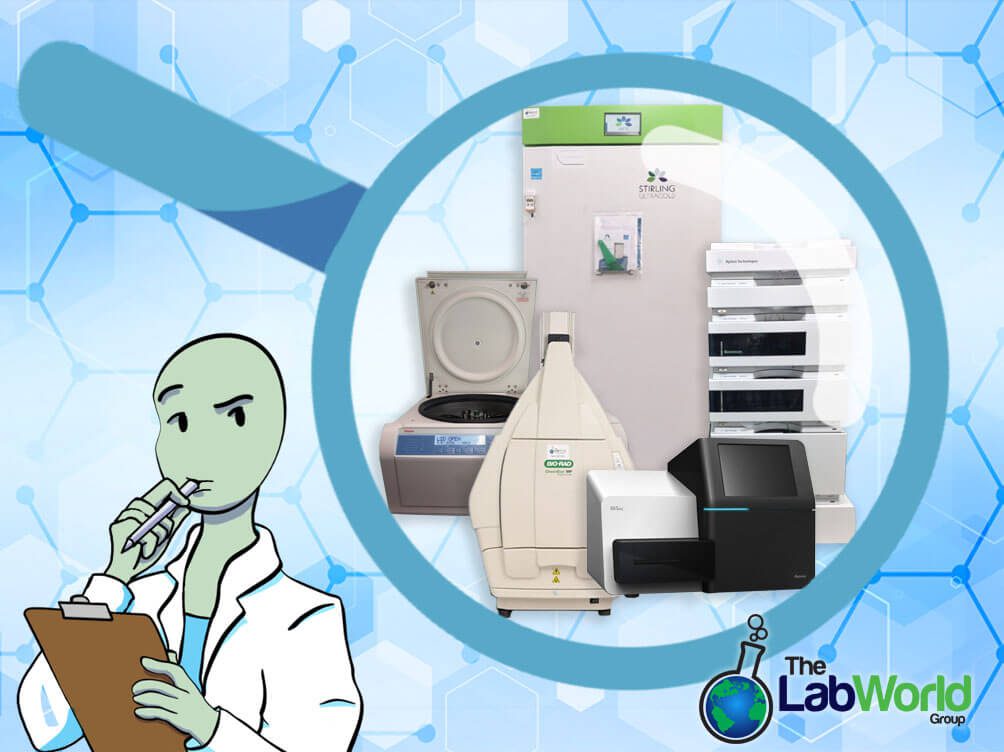
How to Find the Right Lab Instrument
joe2021-08-17T21:50:37+00:00Looking for the right lab instrument isn’t an easy task. If you’re not careful, you may end up buying a lousy lab instrument that breaks after minimal use! This guide is here to help you. Before you buy, it’s essential to figure out price range, quality, product size, volume and operational capacity, and specific features your lab needs. These easy-to-remember steps will help you save thousands of dollars.
Price Range
It’s vital to assess price when considering a lab instrument for sale. Manufacturers purposely overprice some devices because they assume labs are willing to pay thousands of dollars more for basic equipment. Many times, lab facilities do pay more. An example is that for the same exact quality, some newer freezers can cost above $15,000, whereas a used or out-of-box lab freezer can be as cheap as $6,000. That’s why it’s crucial to cruise through multiple listings and get a general idea of what the item is worth and what you should be paying. Another thing to ensure is that whatever product you decide to buy fits your lab’s budget.
Product Quality
Once you’ve found a couple of models well within your price range, you should look at the quality of each one. You can examine the overall quality by checking these metrics: reviews, photos/videos, material, and general lifespan.
Looking at reviews is a great way to assess the quality accurately. People will voice their frustrations via reviews if an item is not working up to par. It would be best if you looked at reviews from multiple sources.
Photos and videos can show you the condition, size comparison, and overall material. Make sure when viewing used lab instruments, that you search for serial numbers as well. Serial numbers indicate that the device in the photo is the one you’ll be receiving. While reviewing specifications and pictures, glance over the material. Certain materials can increase the lifespan and quality of devices. An item made from metal will be easier to maintain than an item made from plastic.
The last thing you should view is the lifespan. Lifespan is a more difficult metric to calculate. A good way to do this is by checking the average product price, reviews (view dates), and purchase frequency. Viewing comparable products can calculate the average product price. If the item you’re viewing is too low in cost, this can indicate low-quality material was used. If the price is higher, this can mean it’s made from high-quality material. When examining reviews, check out negative ones, and read through to see how long their device lasted. Finally, examine the purchase frequency. To do this, check out the number of reviews, and see how many people are purchasing the product. When you wrap all these up, it can give you a general idea if the lab instrument lasts for only a few years or a long time.
Product Size
Determining product size is important before you buy. Undersized labs, especially ones in major cities, might need smaller devices. Larger biotech or manufacturing labs might need bigger devices. A benchtop centrifuge would fit better in smaller labs than, say, a floor model centrifuge which would do better in larger labs. It’s also important to look at the size to ensure it can fit through the door. Some lab instruments can’t fit through basic entry doors and require delivery through shipping docks. Each model size can carry a different function, speed, and operating capacity, which buyers also should consider. Unlike other resellers, you can accurately see product dimensions to determine whether it’s a good size for your lab on our website store.
Operational/Volume Capacity
Examining volume and operating capacity is the most critical factor when buying lab instruments. If you buy a device that doesn’t supply enough volume or operating capacity, it can slow down efficiency, which costs you more time and money. For example, some undercounter freezers store an average of 4 cubic feet of space, whereas larger models can store upwards of 14 cubic feet of space or more. If you don’t have enough space to store your samples, then you’ll have to buy another freezer. In processing equipment (centrifuges, pipette systems, analyzers, etc.), you need to examine what operating volume you need. For example, some centrifuges can process 400ml, while others can process up to 4,000ml. If you buy an instrument with the wrong capacity, you can slow down your overall production rate. Taking the time to go over what operating and volume capacity your lab needs can save you more time and money down the road.
Specific Features
Every lab instrument comes with different features. Knowing what features to look for can significantly make a difference in efficiency when performing lab experiments. For example, some centrifuges are just used for processing samples, whereas others can both process and refrigerate samples simultaneously. Some processing equipment has different speeds, temperatures, displays, and software. As a rule of thumb, if you’re wondering what features you should be looking for, start by examining what type of lab applications and experiments you’re performing. Afterward, assess different instruments to see which one is right for your lab.
Final Thoughts…
Taking the time to review a lab instrument before purchasing it outright will save you more time, money, and headaches. At The Lab World Group, we give you this information with each product we list so you can accurately find a suitable instrument for your lab. We’re experts in laboratory devices with over 20 years of experience collectively and have always ensured our customers go through a headache-free process. Our devices are involved with a strict testing process to ensure everything is working and optimized to factory specifications. We guarantee full transparency, working lab instruments, and priority customer service when you buy from The Lab World Group.
If you’re looking to learn more about buying used lab instruments, check out our ultimate guide for buying used lab instruments.













